Accounting for Managers: Cash Flow, Proposals, and Bidding Analysis
VerifiedAdded on 2023/06/06
|9
|1086
|452
Homework Assignment
AI Summary
This assignment analyzes financial statements, particularly cash flow statements, of JB Hi-Fi, examining the impact of acquisitions and operational changes. It delves into three business proposals, evaluating their potential impact on profitability through quantitative, sensitivity, and break-even analyses. The proposals involve product quality enhancement, price adjustments, and promotional discounts, each assessed for its financial implications. Furthermore, the assignment addresses a bidding scenario, determining the quotation amount required for a contract, considering plant capacity, margin on costs, and incremental costs. The analysis considers both advantages and disadvantages of the bidding decision. References from academic sources support the financial concepts and analyses presented throughout the assignment.

ACCOUNTING FOR MANAGERS
Student Name
[Pick the date]
Student Name
[Pick the date]
Paraphrase This Document
Need a fresh take? Get an instant paraphrase of this document with our AI Paraphraser
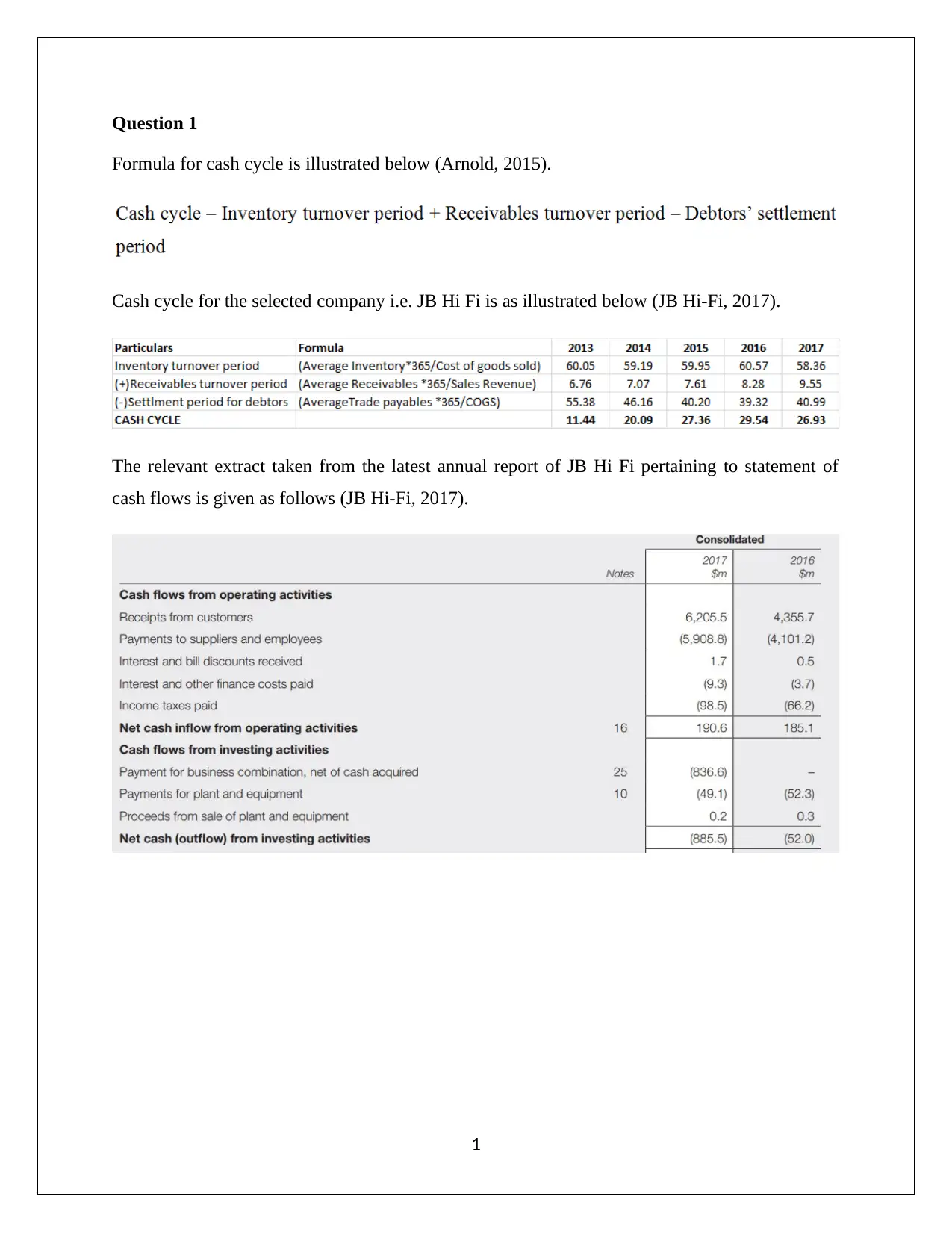
Question 1
Formula for cash cycle is illustrated below (Arnold, 2015).
Cash cycle for the selected company i.e. JB Hi Fi is as illustrated below (JB Hi-Fi, 2017).
The relevant extract taken from the latest annual report of JB Hi Fi pertaining to statement of
cash flows is given as follows (JB Hi-Fi, 2017).
1
Formula for cash cycle is illustrated below (Arnold, 2015).
Cash cycle for the selected company i.e. JB Hi Fi is as illustrated below (JB Hi-Fi, 2017).
The relevant extract taken from the latest annual report of JB Hi Fi pertaining to statement of
cash flows is given as follows (JB Hi-Fi, 2017).
1
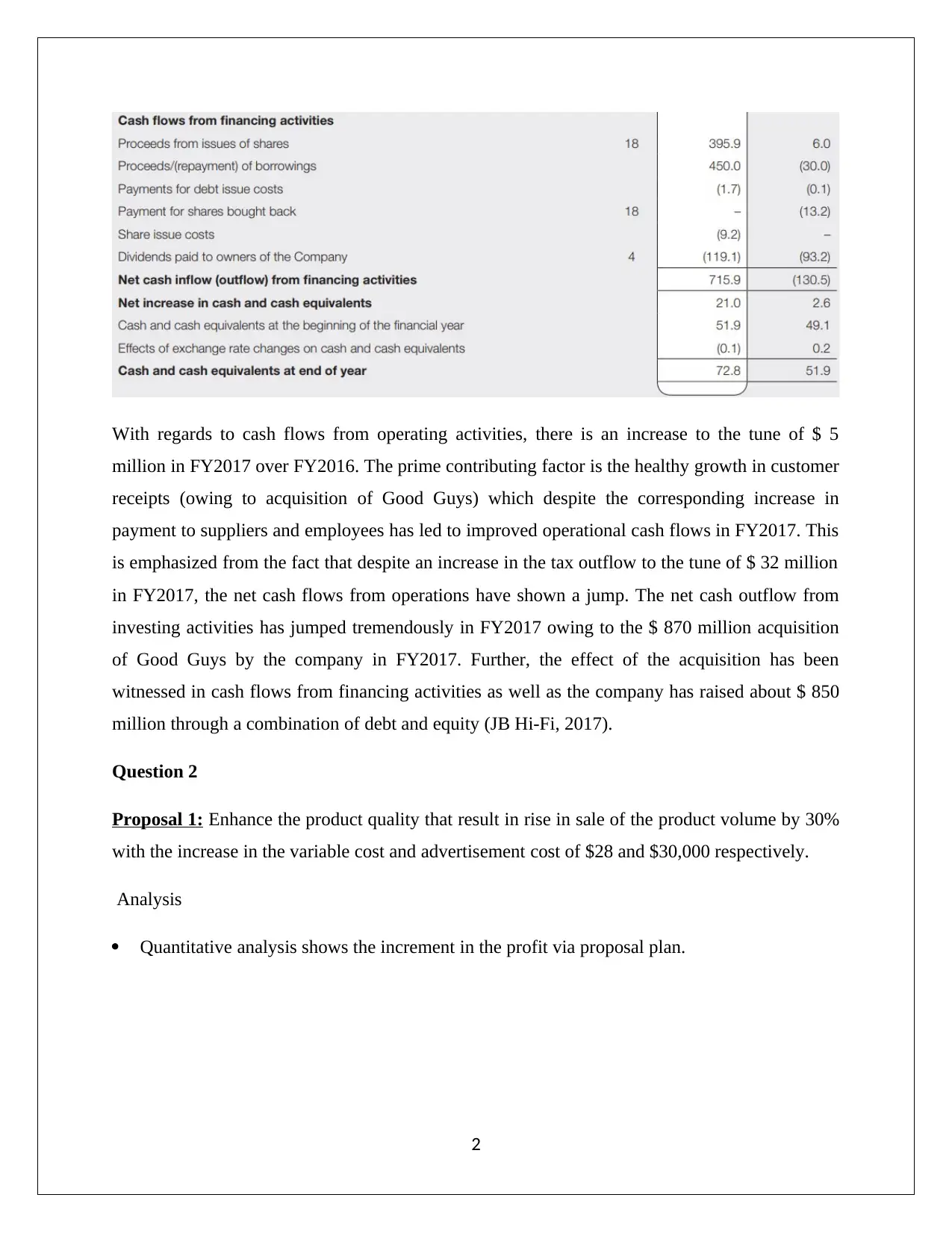
With regards to cash flows from operating activities, there is an increase to the tune of $ 5
million in FY2017 over FY2016. The prime contributing factor is the healthy growth in customer
receipts (owing to acquisition of Good Guys) which despite the corresponding increase in
payment to suppliers and employees has led to improved operational cash flows in FY2017. This
is emphasized from the fact that despite an increase in the tax outflow to the tune of $ 32 million
in FY2017, the net cash flows from operations have shown a jump. The net cash outflow from
investing activities has jumped tremendously in FY2017 owing to the $ 870 million acquisition
of Good Guys by the company in FY2017. Further, the effect of the acquisition has been
witnessed in cash flows from financing activities as well as the company has raised about $ 850
million through a combination of debt and equity (JB Hi-Fi, 2017).
Question 2
Proposal 1: Enhance the product quality that result in rise in sale of the product volume by 30%
with the increase in the variable cost and advertisement cost of $28 and $30,000 respectively.
Analysis
Quantitative analysis shows the increment in the profit via proposal plan.
2
million in FY2017 over FY2016. The prime contributing factor is the healthy growth in customer
receipts (owing to acquisition of Good Guys) which despite the corresponding increase in
payment to suppliers and employees has led to improved operational cash flows in FY2017. This
is emphasized from the fact that despite an increase in the tax outflow to the tune of $ 32 million
in FY2017, the net cash flows from operations have shown a jump. The net cash outflow from
investing activities has jumped tremendously in FY2017 owing to the $ 870 million acquisition
of Good Guys by the company in FY2017. Further, the effect of the acquisition has been
witnessed in cash flows from financing activities as well as the company has raised about $ 850
million through a combination of debt and equity (JB Hi-Fi, 2017).
Question 2
Proposal 1: Enhance the product quality that result in rise in sale of the product volume by 30%
with the increase in the variable cost and advertisement cost of $28 and $30,000 respectively.
Analysis
Quantitative analysis shows the increment in the profit via proposal plan.
2
⊘ This is a preview!⊘
Do you want full access?
Subscribe today to unlock all pages.

Trusted by 1+ million students worldwide
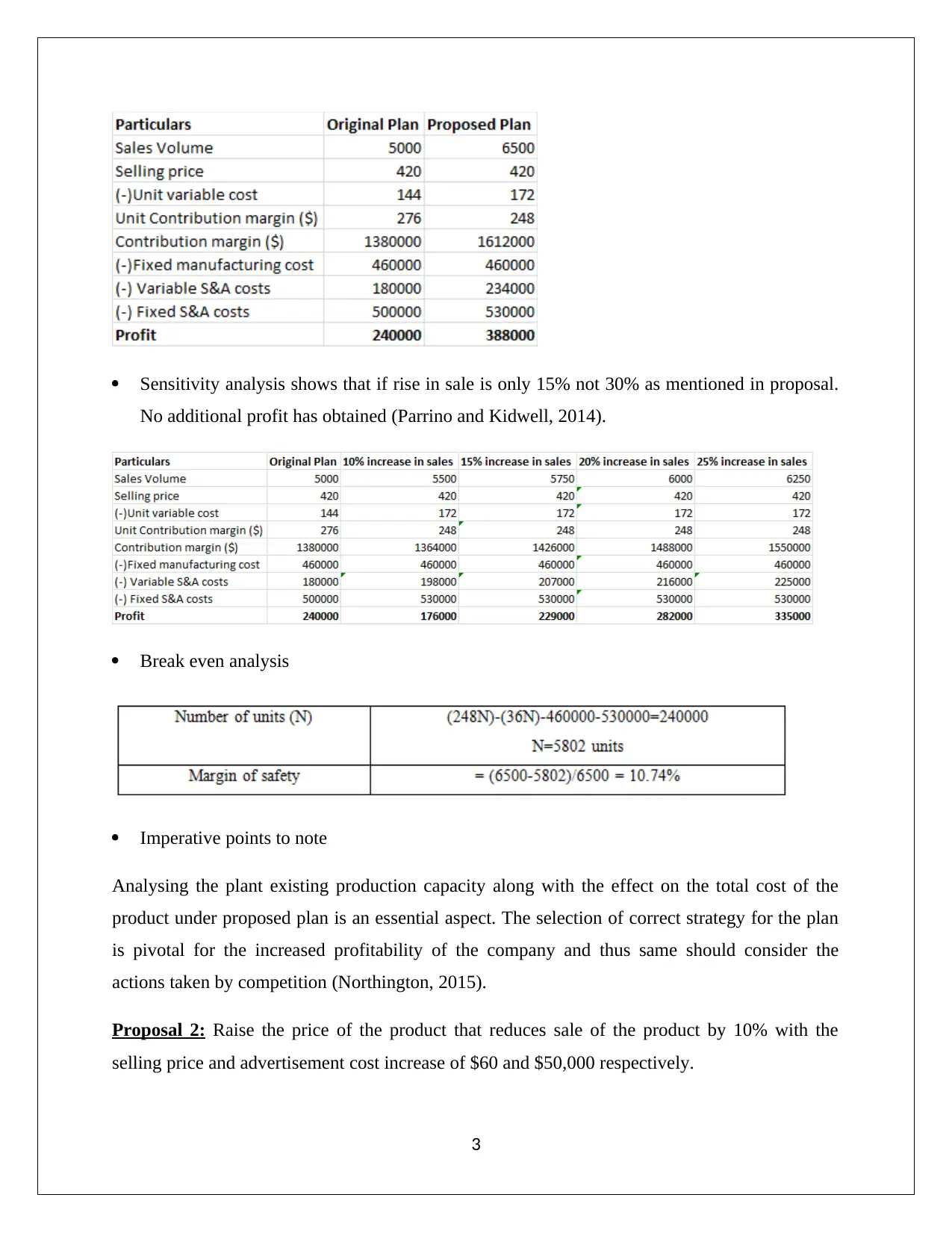
Sensitivity analysis shows that if rise in sale is only 15% not 30% as mentioned in proposal.
No additional profit has obtained (Parrino and Kidwell, 2014).
Break even analysis
Imperative points to note
Analysing the plant existing production capacity along with the effect on the total cost of the
product under proposed plan is an essential aspect. The selection of correct strategy for the plan
is pivotal for the increased profitability of the company and thus same should consider the
actions taken by competition (Northington, 2015).
Proposal 2: Raise the price of the product that reduces sale of the product by 10% with the
selling price and advertisement cost increase of $60 and $50,000 respectively.
3
No additional profit has obtained (Parrino and Kidwell, 2014).
Break even analysis
Imperative points to note
Analysing the plant existing production capacity along with the effect on the total cost of the
product under proposed plan is an essential aspect. The selection of correct strategy for the plan
is pivotal for the increased profitability of the company and thus same should consider the
actions taken by competition (Northington, 2015).
Proposal 2: Raise the price of the product that reduces sale of the product by 10% with the
selling price and advertisement cost increase of $60 and $50,000 respectively.
3
Paraphrase This Document
Need a fresh take? Get an instant paraphrase of this document with our AI Paraphraser

Analysis
Quantitative analysis shows the increment in the profit via proposal plan.
Sensitivity analysis shows that fall in sale is 20% not 10% as mentioned in proposal. Total
profit has been reduced from the initial plan.
Break even analysis
Imperative points to note
It is apparent from the plan that sale would be reduced because of the increase price of product.
Hence, it is critical to analyse the market environment and the respective consequences that can
minimize the competitive advantage particularly due to market share loss (Damodaran, 2015).
4
Quantitative analysis shows the increment in the profit via proposal plan.
Sensitivity analysis shows that fall in sale is 20% not 10% as mentioned in proposal. Total
profit has been reduced from the initial plan.
Break even analysis
Imperative points to note
It is apparent from the plan that sale would be reduced because of the increase price of product.
Hence, it is critical to analyse the market environment and the respective consequences that can
minimize the competitive advantage particularly due to market share loss (Damodaran, 2015).
4
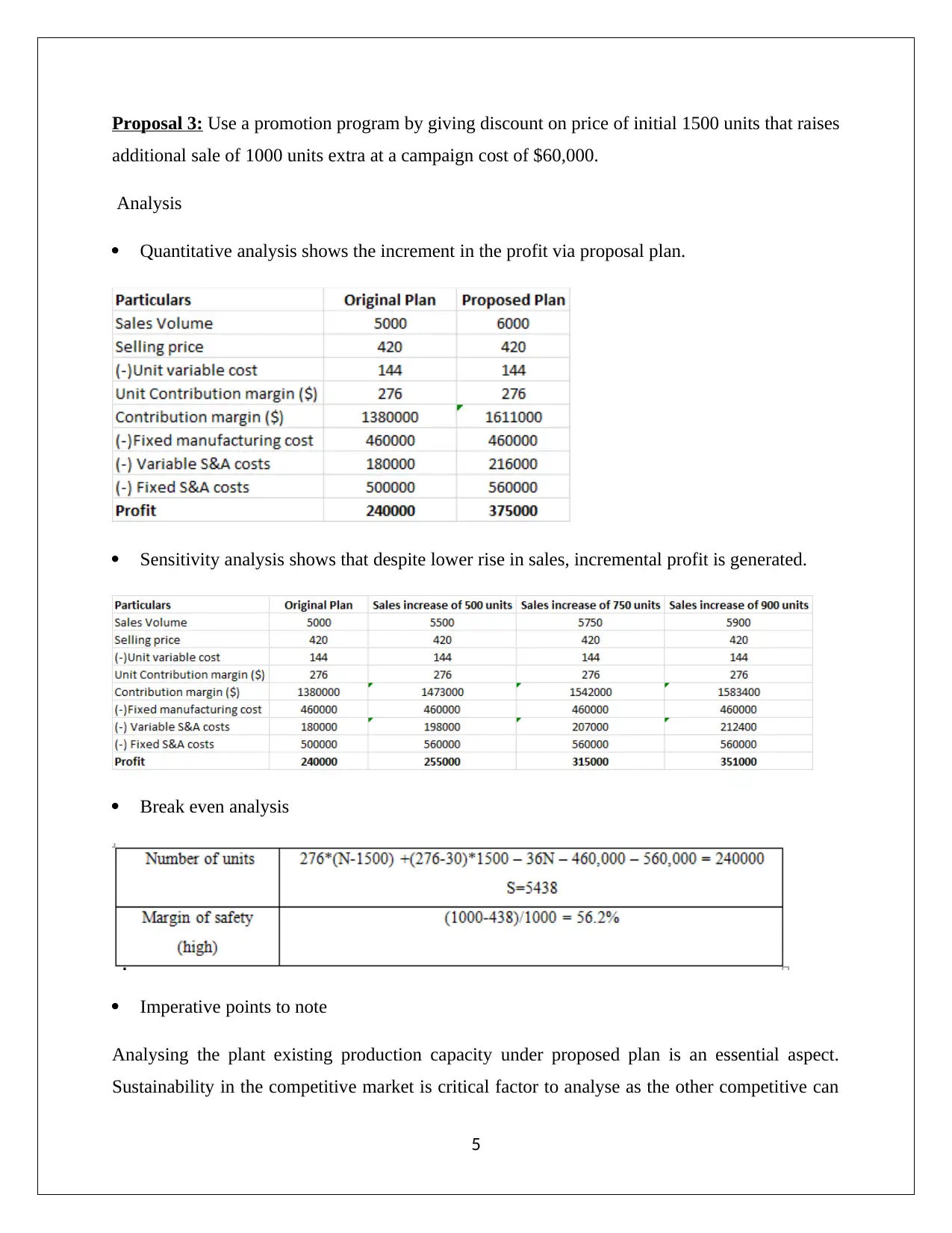
Proposal 3: Use a promotion program by giving discount on price of initial 1500 units that raises
additional sale of 1000 units extra at a campaign cost of $60,000.
Analysis
Quantitative analysis shows the increment in the profit via proposal plan.
Sensitivity analysis shows that despite lower rise in sales, incremental profit is generated.
Break even analysis
Imperative points to note
Analysing the plant existing production capacity under proposed plan is an essential aspect.
Sustainability in the competitive market is critical factor to analyse as the other competitive can
5
additional sale of 1000 units extra at a campaign cost of $60,000.
Analysis
Quantitative analysis shows the increment in the profit via proposal plan.
Sensitivity analysis shows that despite lower rise in sales, incremental profit is generated.
Break even analysis
Imperative points to note
Analysing the plant existing production capacity under proposed plan is an essential aspect.
Sustainability in the competitive market is critical factor to analyse as the other competitive can
5
⊘ This is a preview!⊘
Do you want full access?
Subscribe today to unlock all pages.

Trusted by 1+ million students worldwide
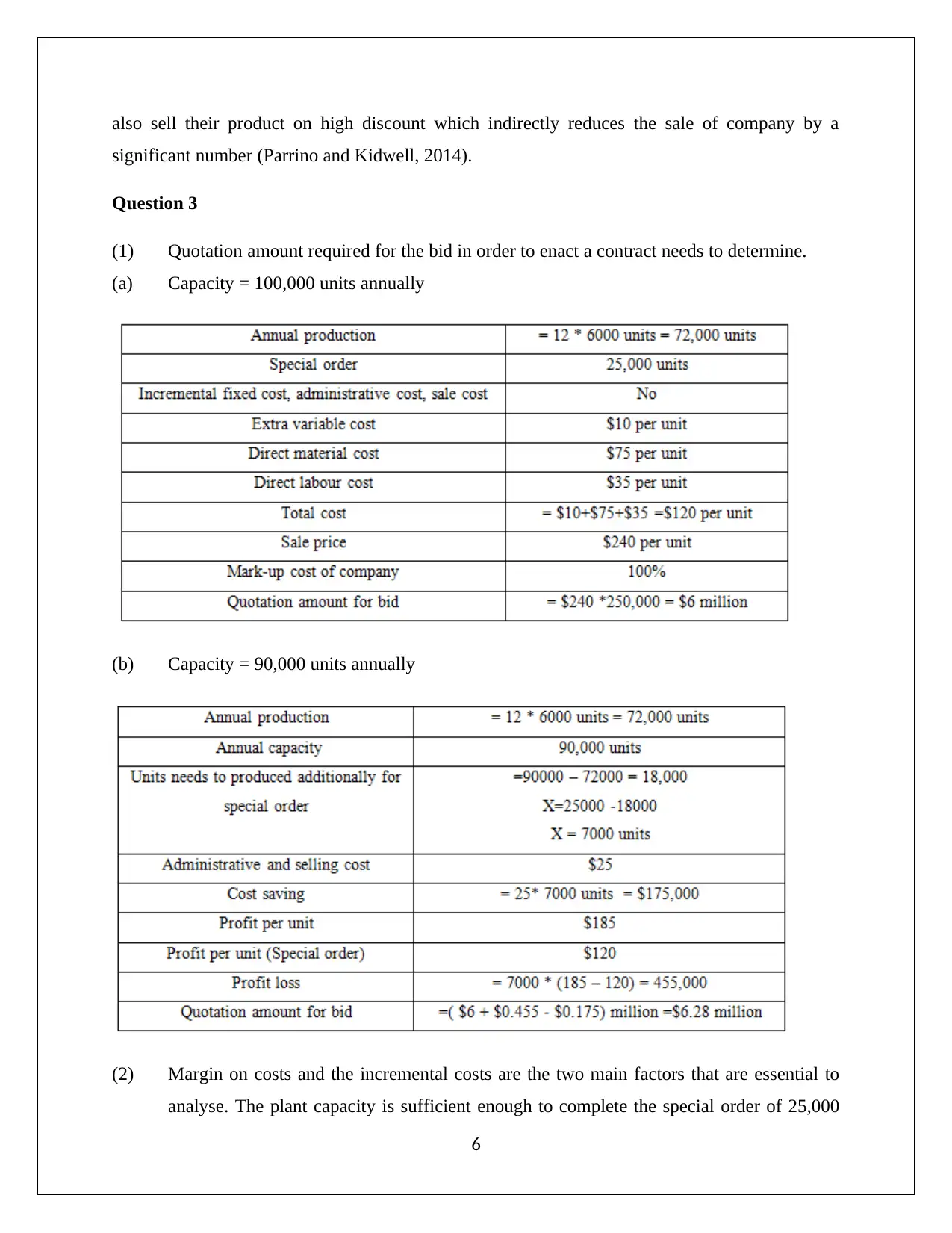
also sell their product on high discount which indirectly reduces the sale of company by a
significant number (Parrino and Kidwell, 2014).
Question 3
(1) Quotation amount required for the bid in order to enact a contract needs to determine.
(a) Capacity = 100,000 units annually
(b) Capacity = 90,000 units annually
(2) Margin on costs and the incremental costs are the two main factors that are essential to
analyse. The plant capacity is sufficient enough to complete the special order of 25,000
6
significant number (Parrino and Kidwell, 2014).
Question 3
(1) Quotation amount required for the bid in order to enact a contract needs to determine.
(a) Capacity = 100,000 units annually
(b) Capacity = 90,000 units annually
(2) Margin on costs and the incremental costs are the two main factors that are essential to
analyse. The plant capacity is sufficient enough to complete the special order of 25,000
6
Paraphrase This Document
Need a fresh take? Get an instant paraphrase of this document with our AI Paraphraser
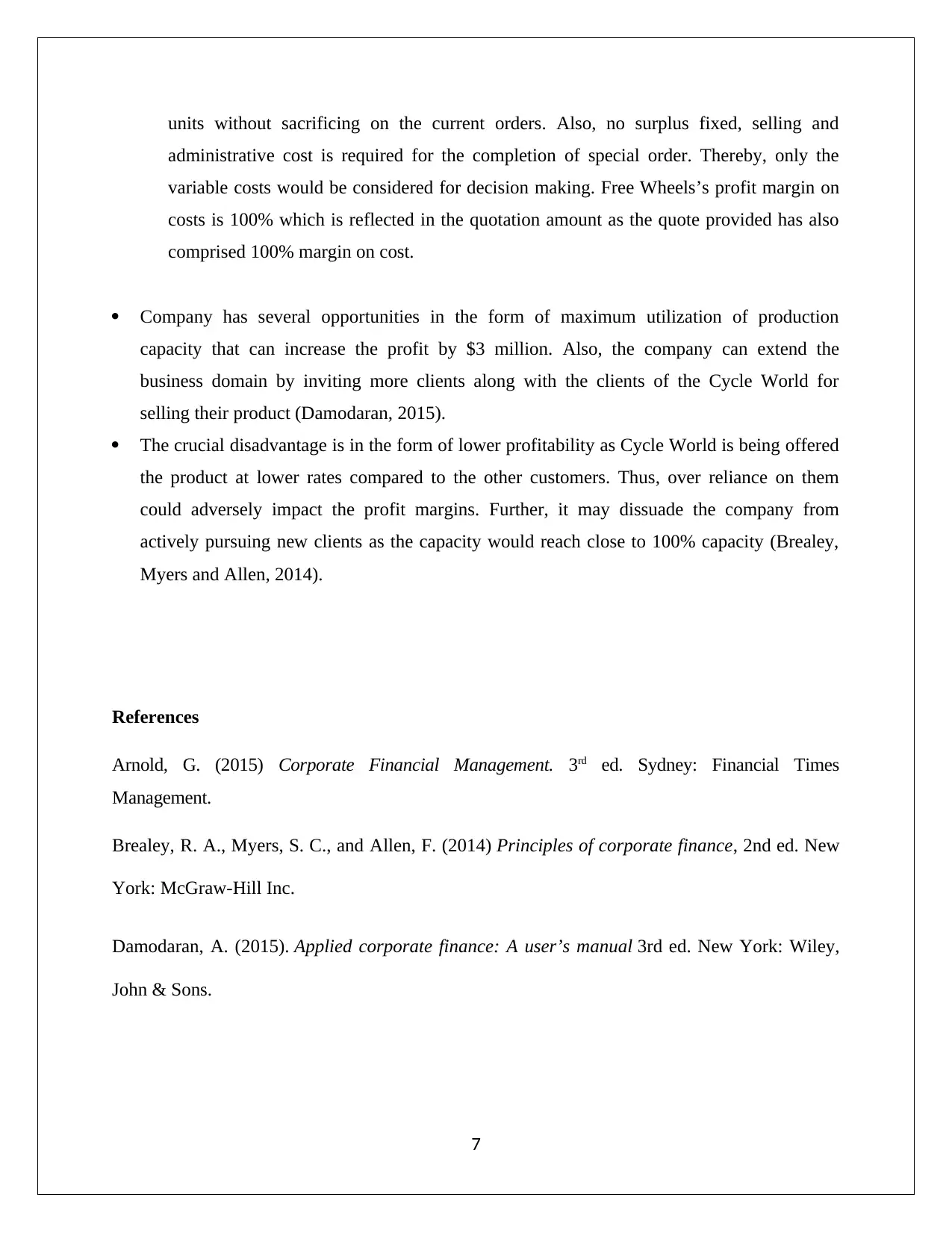
units without sacrificing on the current orders. Also, no surplus fixed, selling and
administrative cost is required for the completion of special order. Thereby, only the
variable costs would be considered for decision making. Free Wheels’s profit margin on
costs is 100% which is reflected in the quotation amount as the quote provided has also
comprised 100% margin on cost.
Company has several opportunities in the form of maximum utilization of production
capacity that can increase the profit by $3 million. Also, the company can extend the
business domain by inviting more clients along with the clients of the Cycle World for
selling their product (Damodaran, 2015).
The crucial disadvantage is in the form of lower profitability as Cycle World is being offered
the product at lower rates compared to the other customers. Thus, over reliance on them
could adversely impact the profit margins. Further, it may dissuade the company from
actively pursuing new clients as the capacity would reach close to 100% capacity (Brealey,
Myers and Allen, 2014).
References
Arnold, G. (2015) Corporate Financial Management. 3rd ed. Sydney: Financial Times
Management.
Brealey, R. A., Myers, S. C., and Allen, F. (2014) Principles of corporate finance, 2nd ed. New
York: McGraw-Hill Inc.
Damodaran, A. (2015). Applied corporate finance: A user’s manual 3rd ed. New York: Wiley,
John & Sons.
7
administrative cost is required for the completion of special order. Thereby, only the
variable costs would be considered for decision making. Free Wheels’s profit margin on
costs is 100% which is reflected in the quotation amount as the quote provided has also
comprised 100% margin on cost.
Company has several opportunities in the form of maximum utilization of production
capacity that can increase the profit by $3 million. Also, the company can extend the
business domain by inviting more clients along with the clients of the Cycle World for
selling their product (Damodaran, 2015).
The crucial disadvantage is in the form of lower profitability as Cycle World is being offered
the product at lower rates compared to the other customers. Thus, over reliance on them
could adversely impact the profit margins. Further, it may dissuade the company from
actively pursuing new clients as the capacity would reach close to 100% capacity (Brealey,
Myers and Allen, 2014).
References
Arnold, G. (2015) Corporate Financial Management. 3rd ed. Sydney: Financial Times
Management.
Brealey, R. A., Myers, S. C., and Allen, F. (2014) Principles of corporate finance, 2nd ed. New
York: McGraw-Hill Inc.
Damodaran, A. (2015). Applied corporate finance: A user’s manual 3rd ed. New York: Wiley,
John & Sons.
7
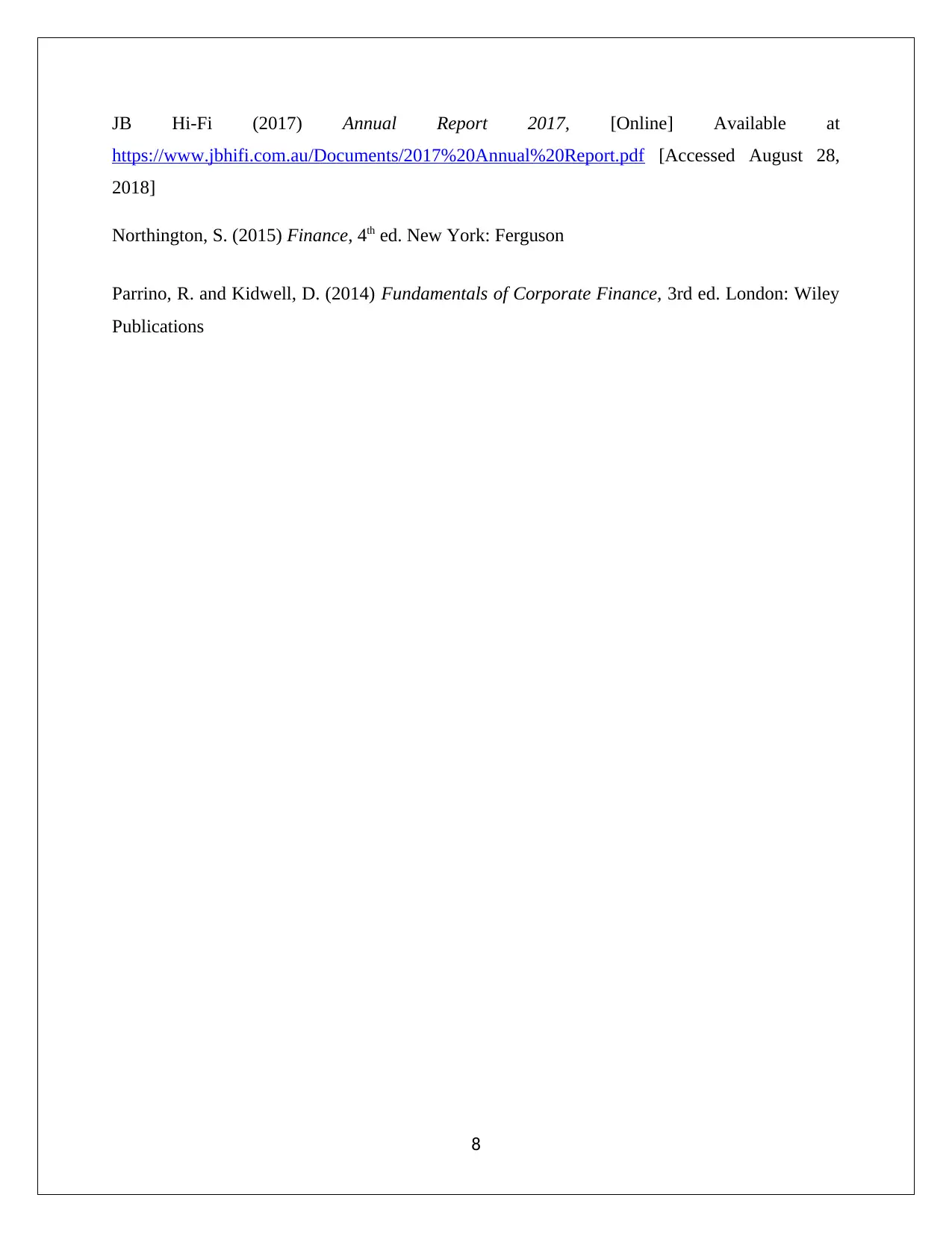
JB Hi-Fi (2017) Annual Report 2017, [Online] Available at
https://www.jbhifi.com.au/Documents/2017%20Annual%20Report.pdf [Accessed August 28,
2018]
Northington, S. (2015) Finance, 4th ed. New York: Ferguson
Parrino, R. and Kidwell, D. (2014) Fundamentals of Corporate Finance, 3rd ed. London: Wiley
Publications
8
https://www.jbhifi.com.au/Documents/2017%20Annual%20Report.pdf [Accessed August 28,
2018]
Northington, S. (2015) Finance, 4th ed. New York: Ferguson
Parrino, R. and Kidwell, D. (2014) Fundamentals of Corporate Finance, 3rd ed. London: Wiley
Publications
8
⊘ This is a preview!⊘
Do you want full access?
Subscribe today to unlock all pages.

Trusted by 1+ million students worldwide
1 out of 9
Related Documents
Your All-in-One AI-Powered Toolkit for Academic Success.
+13062052269
info@desklib.com
Available 24*7 on WhatsApp / Email
![[object Object]](/_next/static/media/star-bottom.7253800d.svg)
Unlock your academic potential
Copyright © 2020–2025 A2Z Services. All Rights Reserved. Developed and managed by ZUCOL.




